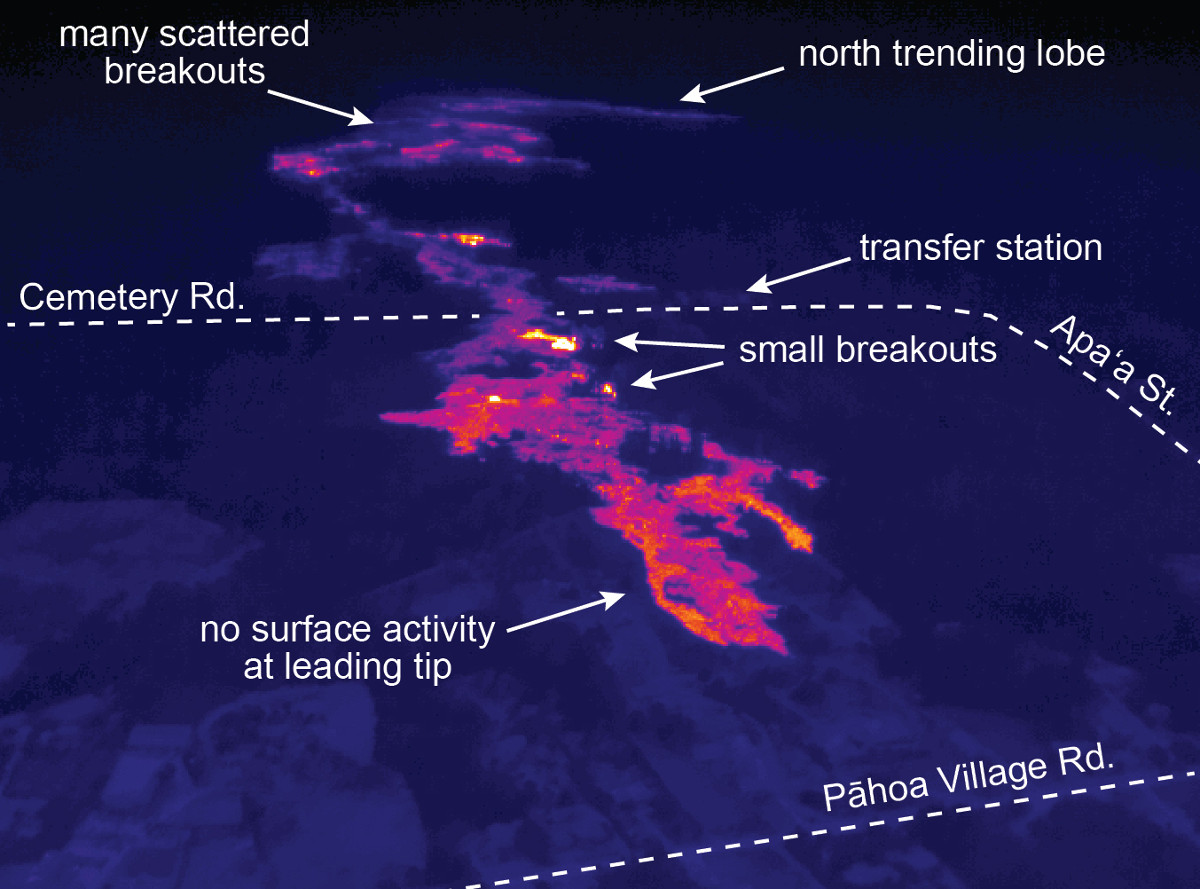(ABOVE VIDEO) Wednesday’s media conference call with video from the ground courtesy Hawaii County and the Hawaii National Guard as well as from the air with Mick Kalber and Paradise Helicopters.
NEWS BRIEFS
- The lava flow front remains stalled 480 feet from the Pahoa Village Road, and it has not advanced over the past six days.
- The USGS Hawaiian Volcano Observatory observed that the “lava level in a lava-tube skylight on the flank of Pu`u `Ō`ō suggests lava discharge remains relatively low” in an update issued last night.
- Although current flow activity has decreased, civil defense says “the evacuation advisory for those residents down slope of the flow will continue and residents will be kept informed of the flow status and advancement.” Pahoa Village Road between Apa’a Street and the Post Office Road will remain closed and limited to area residents only.
PRIMARY SOURCES

This morning’s assessment shows that the flow front remains stalled with very little activity and has not advanced over the past six days. The flow pad continues to show signs of inflation which could result in breakouts and more activity. The front remains approximately 480 feet from the Pahoa Village Road. The upslope breakouts remain approximately .7 to 1.5 miles above the Apa’a Street area and along the north side of the flow and moving in a north/northeast direction. Active burning along the flow edges in the areas of the cemetery and above the transfer station was noted and limited to the vegetation in contact with the flow.
Smoke conditions are light with variable winds winds. Smoke conditions may increase in some areas and residents down wind that may be sensitive or have respiratory problems are advised to take necessary precautions and to remain indoors.
Although current flow activity has decreased, the evacuation advisory for those residents down slope of the flow will continue and residents will be kept informed of the flow status and advancement.
The Pahoa Village Road between Apa’a Street and the Post Office Road will remain closed and limited to area residents only. In addition, Civil Defense and public safety personnel will be operating in the area round the clock to maintain close observations of flow activity.
Additional updates will be broadcasted as conditions change.
We would like to thank everyone for your patience and understanding and your cooperation and assistance is greatly appreciated.Hawaii County Civil Defense on Nov. 6 at 8 a.m. HST

Kīlauea volcano continued to erupt at its summit and within its East Rift Zone, and gas emissions remained elevated. As of Wednesday morning, the leading edge of the June 27th lava flow had not advanced beyond where it stalled late last week. Activity continued behind the lava flow’s leading edge, within the flow’s interior, and along its side margins, with localized breakouts of molten lava. An overflight by HVO scientists on Wednesday afternoon observed no breakouts closer than about 500 m (550 yards) from the flow front. Only very minor inflationary tilt occurred at Kīlauea’s summit, and the level of the summit lava lake at Halemaʻumaʻu Crater was similar to the previous day.
June 27th Lava Flow Observations: Visual and thermal observations during HVO’s Wednesday overflight confirmed that the leading tip of the flow had not advanced beyond where it stalled late last week, in a residential area approximately 155 meters (170 yards) above Pāhoa Village Road. Active breakouts persisted in areas upslope of the leading edge and from lobes along the flow margins, and the interior of the flow continued to inflate. No breakouts were observed closer than about 500 m (550 yards) from the flow front. Most surface activity was located above Apaʻa Street, and a County Civil Defense overflight on Thursday morning confirmed continued breakout activity approximately 1.1 km (0.7 miles) to 2.5 km (1.5 miles) above Apaʻa.
Puʻu ʻŌʻō Observations: Views of the crater were mostly obscured by thick fumes during HVO’s Wednesday overflight. Thermal imagery detected several minor overflows from a vent in the south pit in Puʻu ʻŌʻō’s crater. Seismic tremor continued at low and relatively steady amplitudes, and no earthquakes were located in the vicinity of the cone. The most recent sulfur-dioxide emission-rate measurement for the East Rift Zone was 320 tonnes per day (from all sources) on October 31, 2014. The tiltmeter nearest Puʻu ʻŌʻō is undergoing maintenance and is currently offline.
Summit Observations: Only very minor inflationary tilt occurred at Kīlauea’s summit. Several small earthquakes were located beneath the summit, and volcanic tremor persisted at low, fluctuating amplitudes. On Wednesday, Nov 5 at ~0830h, the level of the lava lake in the Overlook vent was measured to be 58 m (63 yards) below the vent rim, and web cam images showed only minor fluctuations in lava lake level over the preceding day. Small amounts of particulate material were carried aloft by the plume. Sulfur-dioxide emission-rate measurements for the summit ranged from 3,400 up to 6,400 tonnes/day (see caveat below) through the week-long period ending November 4, 2014. USGS Hawaiian Volcano Observatory on Nov. 6 at 8:57 a.m. HST

This USGS HVO photo is a thermal image of the flow front. The warm (but not hot) temperatures (red and orange) around the leading tip of the flow indicate that no surface flows are active in this area. Several small breakouts are active a short distance upslope, near the cemetery, and are visible by their higher temperatures (yellow, white). Upslope of Cemetery Rd./Apaʻa St., scattered breakouts remain active. A lobe about 2.5 km (1.5 miles) upslope of Cemetery Rd./Apaʻa St. has expanded the flow margin towards the north.

by Big Island Video News9:09 am
on at
STORY SUMMARY
The lava flow front remains stalled 480 feet from the Pahoa Village Road, and it has not advanced over the past six days.